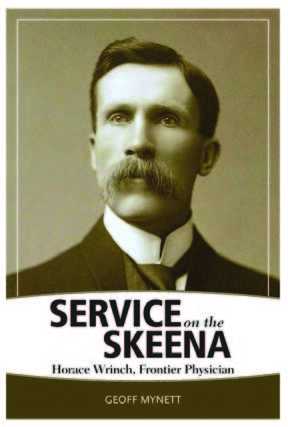Book review: Service on the Skeena: Horace Wrinch, Frontier Physician
 |
|
Service on the Skeena: Horace Wrinch, Frontier Physician |
The achievements of physicians working in remote areas in the early days of this country are legendary. In his book Service on the Skeena, Mynett does us great service by telling the story of one of those legendary pioneers. It is a fascinating story of Harold Wrinch, a man motivated by service, dedicated to the people of a remote region, working through tremendous challenges to provide care to Indigenous communities as well as to isolated and sometimes fractious settlers. A true generalist, Wrinch’s name deserves wide recognition as one of the outstanding medical pioneers of the country.
Horace Wrinch arrived with his wife in the Upper Skeena in 1900 to serve the people of the region and was responsible, as the only physician, for providing care over hundreds of miles in every direction. In the days when churches in Canada took considerable responsibility for providing hospital care, Wrinch brought a deep faith as well as remarkable medical skill to his work.
This doctor, with early training in agriculture, not only provided essential medical services, but built two hospitals, established a nursing school, and created a farm that supplied the hospitals. He also provided an early practical example of medical insurance, years before it became a topic of wide concern, in order to better provide for the people of the Upper Skeena.
This biography—well researched and well written—provides in-depth local history, wonderful stories of early medicine in the Upper Skeena, and anecdotes of the challenges Wrinch faced. For instance, not long after arriving in the Upper Skeena, he was required to write examinations in order to qualify for a licence to practise in British Columbia. This involved a 125-mile winter hike from Hazelton to Stewart, boat travel to Victoria, and then a return journey, all of which took over a month.
Mynett not only tells the story of Wrinch’s remarkable medical achievements, including his lockdown of Northern BC during the Spanish flu epidemic, but also of his involvement in the famous Simon Gunanoot case. He also details Wrinch’s work as a member of the provincial legislature in trying to create a form of provincial health insurance in the 1930s.
This book will greatly appeal to those interested in the history of medicine, the local history of early British Columbia and the people who built it, and the history of the church’s work in medicine.
I highly recommend this excellent biography of an outstanding pioneer doctor.
—Peter Newbery, MDiv, MD
Hazelton
